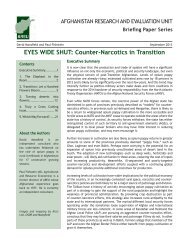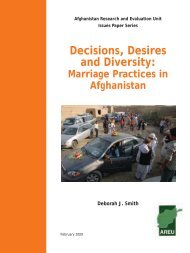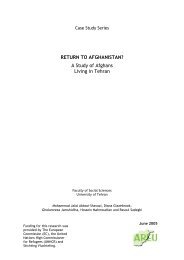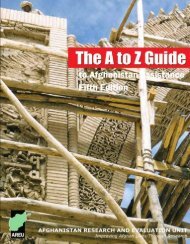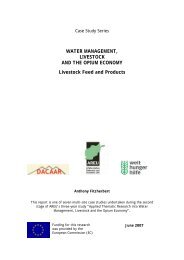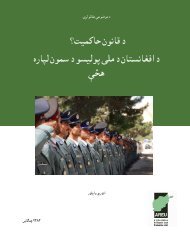Local Governance in Afghanistan: A View from the Ground
Local Governance in Afghanistan: A View from the Ground
Local Governance in Afghanistan: A View from the Ground
- No tags were found...
Create successful ePaper yourself
Turn your PDF publications into a flip-book with our unique Google optimized e-Paper software.
<strong>Afghanistan</strong> Research and Evaluation Unit<br />
2011<br />
<strong>the</strong> construction of reta<strong>in</strong><strong>in</strong>g walls to prevent flood<strong>in</strong>g—along with improv<strong>in</strong>g public health through<br />
<strong>the</strong> provision of clean dr<strong>in</strong>k<strong>in</strong>g water. Where CDCs were work<strong>in</strong>g at <strong>the</strong>ir best, <strong>the</strong>re were often good<br />
l<strong>in</strong>kages with district l<strong>in</strong>e m<strong>in</strong>istries.<br />
In many of <strong>the</strong> Taliban-controlled areas CDCs were able to operate but had no contact with district<br />
officials. The NSP was viewed with suspicion by <strong>the</strong> Taliban <strong>in</strong> Wardak, who were concerned that<br />
l<strong>in</strong>ks with facilitat<strong>in</strong>g partners could be used to pass on <strong>in</strong>formation about <strong>the</strong>m. However, <strong>the</strong>re<br />
were several examples of elders negotiat<strong>in</strong>g with <strong>the</strong> Taliban to persuade <strong>the</strong>m of <strong>the</strong> programme’s<br />
benefits. In Laghman <strong>the</strong> Taliban were quite flexible <strong>in</strong> <strong>the</strong> way <strong>the</strong>y permitted NSP to operate.<br />
Even <strong>in</strong> more stable prov<strong>in</strong>ces people described how <strong>the</strong> NSP was <strong>in</strong>itially viewed with suspicion by<br />
commanders and mullahs who called it “un-Islamic.” However, when <strong>the</strong>y saw how <strong>the</strong> CDCs received<br />
funds and delivered development, <strong>the</strong>y supported and jo<strong>in</strong>ed <strong>the</strong>m.<br />
An important pr<strong>in</strong>ciple of NSP has been <strong>the</strong> <strong>in</strong>clusion of women. In practice this has been through<br />
<strong>the</strong> formation of separate CDCs, although <strong>in</strong> Day Kundi, Jawzjan and Sar-i-Pul women sometimes<br />
participated <strong>in</strong> <strong>the</strong> same CDC as <strong>the</strong> men, and on some occasions <strong>the</strong>re were even female CDC<br />
heads. Where this was not <strong>the</strong> case, facilitat<strong>in</strong>g partners paid particular attention to help<strong>in</strong>g female<br />
CDCs undertake <strong>in</strong>come generation projects, such as carpet weav<strong>in</strong>g and tailor<strong>in</strong>g, and push<strong>in</strong>g <strong>the</strong><br />
boundaries of female participation wherever possible. This was by no means easy s<strong>in</strong>ce women were<br />
often wary of <strong>the</strong> consequences of provok<strong>in</strong>g male sensibilities. In Day Kundi women were <strong>in</strong> CDCs<br />
because <strong>the</strong> men had <strong>in</strong>itially not understood <strong>the</strong> potential of NSP. Never<strong>the</strong>less, it was not unusual<br />
to f<strong>in</strong>d that allocations <strong>in</strong>tended for women (e.g. livestock) were co-opted by men. In most prov<strong>in</strong>ces<br />
female CDCs had a restricted level of activity and had no control over budgets and <strong>the</strong>re were many<br />
<strong>in</strong>stances, particularly <strong>in</strong> Laghman and Wardak, of <strong>the</strong>se bodies exist<strong>in</strong>g only on paper.<br />
Despite NSP’s successes, <strong>the</strong>re rema<strong>in</strong> a number of concerns over its operation:<br />
• The <strong>in</strong>tegrity of CDCs is subject to various forms of <strong>in</strong>fluence and mediation. Some facilitat<strong>in</strong>g<br />
partners noted that villagers were com<strong>in</strong>g under <strong>in</strong>creas<strong>in</strong>g pressure <strong>from</strong> prov<strong>in</strong>cial council<br />
members and woluswals on issues such as elections, contracts and aid distribution. In some<br />
villages, CDC members were allied to political parties and <strong>the</strong> body thus became a space for<br />
act<strong>in</strong>g out political rivalries.<br />
• Development projects conceived with<strong>in</strong> <strong>the</strong> context of <strong>the</strong> village were piecemeal and failed to<br />
generate <strong>in</strong>ter-village or <strong>in</strong>tra-district synergies.<br />
• The NSP’s def<strong>in</strong>ition of communities and households are potentially problematic. In some<br />
<strong>in</strong>stances, <strong>the</strong> def<strong>in</strong>ition of a household was manipulated to double <strong>the</strong>ir number <strong>in</strong> a village.<br />
Contrast<strong>in</strong>gly, <strong>the</strong>re were examples of communities be<strong>in</strong>g split <strong>in</strong> order to meet NSP criteria.<br />
In one prov<strong>in</strong>ce such a split was <strong>the</strong> cause of conflict <strong>in</strong> a formerly unified community over <strong>the</strong><br />
ownership of a road.<br />
• For <strong>the</strong> most part, female participation is nom<strong>in</strong>al. Where women are able to engage with NSPfunded<br />
projects, <strong>the</strong>y often have little control over resources. Women’s participation is heavily<br />
dependent on <strong>the</strong> quality and perseverance of <strong>the</strong> facilitat<strong>in</strong>g partner.<br />
• In certa<strong>in</strong> cases, CDCs may actually <strong>in</strong>crease <strong>the</strong> likelihood of community-level disputes by<br />
comb<strong>in</strong><strong>in</strong>g large <strong>in</strong>fusions of cash with a lack of self-enforc<strong>in</strong>g accountability mechanisms. 60 Such<br />
processes were most apparent where projects raised issues of land ownership or water rights.<br />
• CDC projects are vulnerable to corruption. There were <strong>in</strong>stances of CDC heads collud<strong>in</strong>g with<br />
contractors <strong>in</strong> charg<strong>in</strong>g for shadow labour. There was manipulation of receipts result<strong>in</strong>g <strong>in</strong> <strong>the</strong><br />
purchase of sub-specification materials.<br />
• NSP funds are subject to capture by <strong>in</strong>fluential people and commanders <strong>in</strong> control of CDCs. This<br />
has led to requests by some woluswals for improved monitor<strong>in</strong>g and greater public transparency.<br />
60 Jennifer Brick “The Political Economy of Customary Village Organizations <strong>in</strong> Rural <strong>Afghanistan</strong>” (Madison: Department of<br />
Political Science, University of Wiscons<strong>in</strong>, Madison), 27.<br />
<strong>Local</strong> <strong>Governance</strong> <strong>in</strong> <strong>Afghanistan</strong>: A <strong>View</strong> <strong>from</strong> <strong>the</strong> <strong>Ground</strong><br />
34



